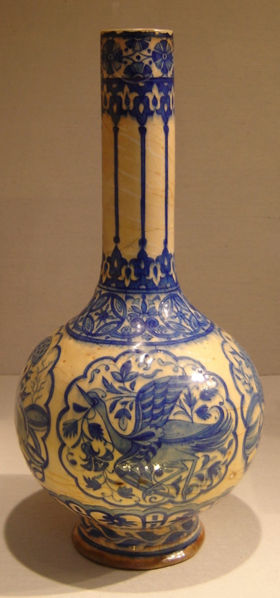












Glazing is the process of coating the piece with a thin layer the raw materials which, after being fired in a kiln, will form a hard, glass-like coating.
Glazing is functionally important for earthenware vessels, which would otherwise be unsuitable for holding liquids due to porosity. Glaze is also used on functional and decorative stoneware and porcelain. In addition to the functional aspect of glazes, aesthetic concerns include a variety of surface finishes, including degrees of gloss and matt, variegation and finished color. Glazes may also enhance an underlying design or texture which may be either the "natural" texture of the clay or an inscribed, carved or painted design.
Glaze is used on building materials. The Iron Pagoda, built in 1049 CE in Kaifeng, China, of glazed bricks is an example.
Glaze may be applied by dry dusting a dry mixture over the surface of the clay body. Liquid glazes—suspensions of various powdered minerals, and metal oxides—can be applied by dipping pieces directly into the glaze, pouring the glaze over the piece, spraying it onto the piece with an airbrush or similar tool, with a brush, or with any tool that will achieve the desired effect.
To prevent the glazed article sticking to the kiln during firing either a small part of the item is left unglazed or special refractory supports, kiln spurs, are used as supports which are removed and discarded after the firing. Small marks left by these spurs can sometimes be visible on finished ware.
Decoration applied under the glaze on pottery is generally referred to as underglaze. Underglazes are applied to the surface of the pottery, which can be either raw, "greenware", or "bisque" fired (an initial firing of some articles before the glazing and re-firing). A wet glaze—usually transparent—is applied over the decoration. The pigment fuses with the glaze, and appears to be underneath a layer of clear glaze. An example of underglaze decoration is the well-known "blue and white" porcelain famously produced in England, The Netherlands, China and Japan. The striking blue color is achieved by using the powerful colorant cobalt in the form of either cobalt oxide or cobalt carbonate, both of which are still commonly used in glaze formulation today.
Decoration applied on top of a layer of glaze is referred to as overglaze. Overglaze methods include applying one or more layers or coats of glaze on a piece of pottery or by applying a non-glaze substance such as enamel or metals (i.e., gold leaf) over the glaze.
Overglaze colors are low-temperature glazes that give ceramics a more decorative, glassy look. A piece is fired first, overglaze is applied, and it is fired again. Once the piece is fired and comes out of the kiln, its texture becomes smoother because of the glaze.
By Appointment
PARIS CERAMICS
South Park Studios - Suite 10
88 Peterborough Road, London SW6 3HH
United Kingdom